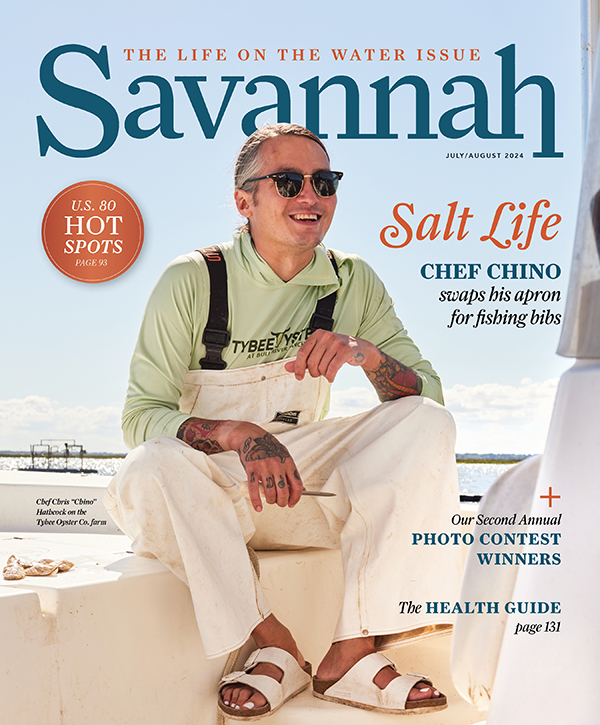During her ongoing quest for “near-native” status, Andrea Goto gets a history lesson…and samples the punch.
There is something inherently old-timey about Jefferson Kirkland, as if he was plucked out of 1852 and dropped into a modern-day Savannah. He’s thoughtful and poised beyond his 32 years, and his full beard disguises what I think may be a very youthful face. Jefferson’s father, Talley, on the other hand, hunches forward enthusiastically and always appears as if he’s on the verge of laughter, so much that I wonder if he’s ever met a bad day in his life. He’s an entertainer by nature—throwing out punchlines like confetti—and a park ranger by profession. However different, these two men share a quaint, timeless spirit. It’s a quality I’ve seen in Southerners who have a profound reverence for history and tradition.
 Jefferson and Talley are active members of the 48th New York Volunteer Infantry—a group of approximately 20 men reenacting the characters of the real-life unit that fought during the Civil War. The founding members launched the reenactment unit in the late 1980s, and the Kirklands became involved when they started doing programs at Fort Pulaski. Unlike men who parade around fields declaring, “The South will rise again!” while taking calls on their cell phones, this particular reenactment unit puts a premium on education and authenticity.
Jefferson and Talley are active members of the 48th New York Volunteer Infantry—a group of approximately 20 men reenacting the characters of the real-life unit that fought during the Civil War. The founding members launched the reenactment unit in the late 1980s, and the Kirklands became involved when they started doing programs at Fort Pulaski. Unlike men who parade around fields declaring, “The South will rise again!” while taking calls on their cell phones, this particular reenactment unit puts a premium on education and authenticity.
“We dress from the underwear out,” explains Jefferson. “And the food we eat, the things we do are all as near as we can get to period.” The unit’s campaign-style camping means forgoing all modern conveniences. For Jefferson, the biggest sacrifice is going without a chair.
I try testing the waters of the Civil War experience. After all, Talley tells me that a handful of women disguised themselves as soldiers, only to be found out when they were injured or killed. I, however, am not passable as a reenactor, let alone a soldier. In my rented Civil War costume—er, uniform—I feel more like Buffalo Bill in drag than Robert E. Lee. I have to be informed which side I was fighting on and only learn I’m a general when Talley greeted me as such—the kind of offenses that will get you traded to the enemy for hardtack.
Additionally, I have a very healthy relationship with bug spray and running water, so I opt to lose the itchy clothes and try a new approach to living history.
“What did they drink?”
Cocktails, anyone?
Andrew Tice, the owner of Angel’s BBQ by day and student of historical recipes and techniques by night, hands me a recipe for Chatham Artillery Punch and a warning that people have strong feelings about the drink.
“After Prohibition,” he explains, “Chatham Artillery Punch evolved basically into a fruit cup. And that’s not what it was supposed to be.”
He explains that the punch originated when soldiers of the Chatham Artillery, the oldest organized artillery regiment in Georgia, basically threw together the booze they had on hand. They liked what they concocted, and this evolved into a recipe they would serve to visiting dignitaries. It is said that the punch is stronger than the gunfire from the two brass cannons George Washington presented to the Chatham Artillery in 1791—the same guns on display on East Bay Street.
The recipe Andrew gives me is intended for an entire battalion. I don’t have that many friends—nor do I have a swimming pool to mix it in.
“Can’t I just order a glass at a bar?” I ask.
He stares at me, unflinching. I guess that’s a no.
I find a willing participant in George Woods, a West Point graduate, former Artillery Captain and self-proclaimed mixologist. To boot, he’s also a member of the Honorable Order of St. Barbara, and has consequently participated in numerous Artillery Punch ceremonies, which sound to me like a mix between a Catholic wedding and Shakespeare community theatre. It’s jam-packed with tradition as the “Master of the Punch” calls forth men to dramatically present the “charges,” or ingredients—a list laced with obscure metaphor. For example, “corn squeezin’s” are said to somehow represent the Artillery’s “American heritage as citizen-soldiers who served honorably and well at a moment’s notice.”
The overwhelming stench of alcohol makes my nose hairs dance as we pour the various bottles together. Although the recipe calls for the punch to sit for two days, I’m a modern woman—I don’t have one minute to wait on a Pop-Tart, let alone two days for my drink to marinate. But three sips in, I forget that I have to be anywhere ever again. The flavor is surprisingly mild considering the gunpowder we loaded it with. I take comfort in George’s assurance that it tastes authentic—and even more comfort in sipping it inside a bug-free home complete with running water.
The Kirklands, Andrew and George surely have a better sense of the past than I, not only because they read about it in a book, but also because they put a premium on authenticity. Consequently, they seem bigger than this lifetime, as if their authentic experiences allow them to jump across time. Or maybe that’s just the punch talking.
Chatham Artillery Punch
Recipe courtesy of Andrew Tice of Angel’s BBQ
1½ gallon Catawba wine
1½ gallon Chinese gunpowder tea, brewed
½ gallon gold rum
1½ quart rye
1 quart gin (Old Tom, Dutch or Plymouth)
1 quart brandy
2 pounds brown sugar or cane syrup
18 oranges, halved and juiced
18 lemons, halved and juiced
½ pint maraschino liqueur
Mix all the ingredients and age for two days, then add:
6 bottles Champagne
Fresh pineapple for garnish
1 block of ice
For your own history lesson, visit
Old Fort Jackson >> 1 Fort Jackson Road, 912-232-3945
Fort Pulaski National Monument >> U.S. 80 East, 912-786-5787
Wormsloe Historic Site >> 7601 Skidaway Road, 912-353-3023




